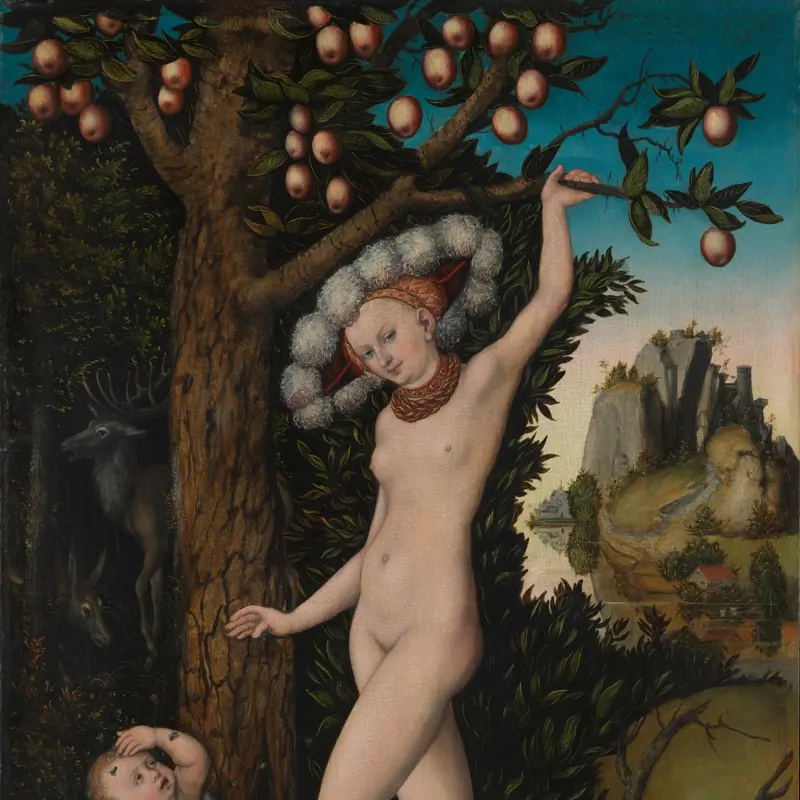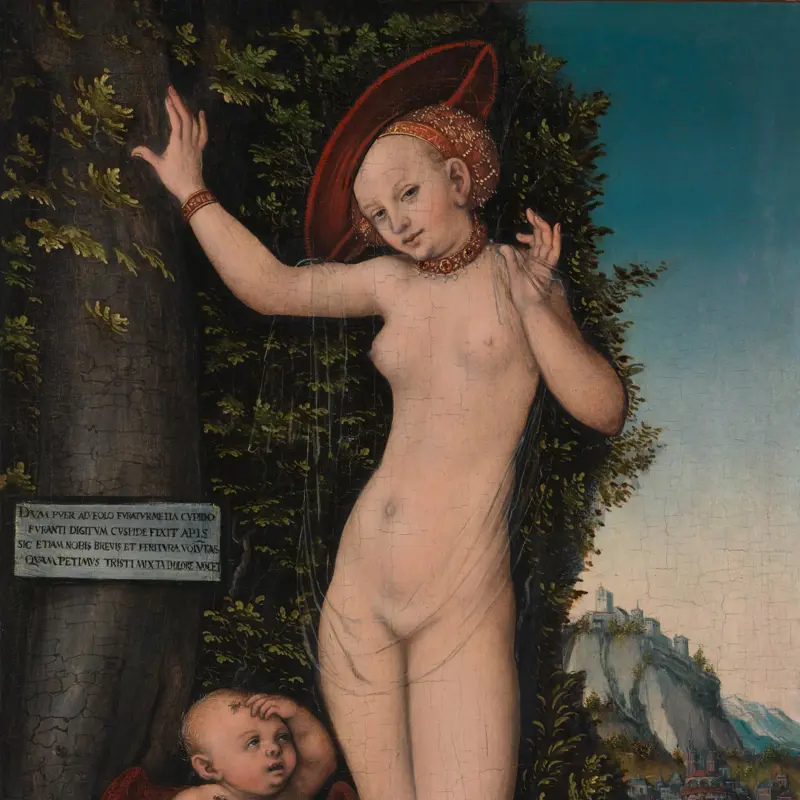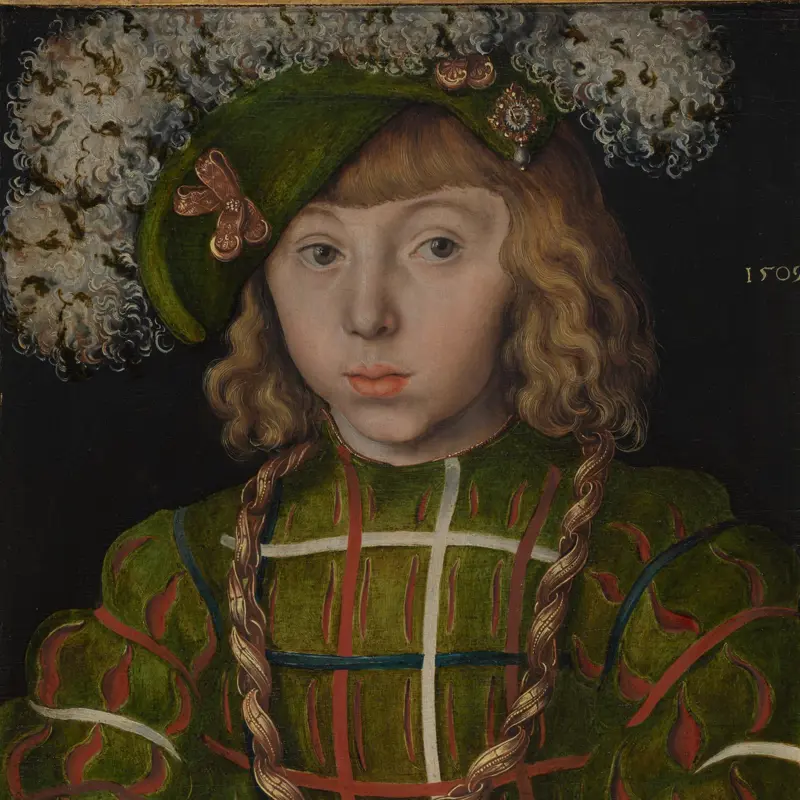Lucas Cranach the Elder, 'Primitive People', 1527-30
About the work
Overview
The subject of this painting has been much debated, but it’s generally thought to show an imagined view of a past and primitive society. Cranach made a number of similar paintings from 1527 to 1535. Since the twentieth century it has been assumed that the origin of the subject lies in a classical source.
Two pairs of men are fighting – violence which is more disturbing for its close proximity to three small children. While one woman watches the fighting with a look of shock on her face, another is staring at something over her shoulder, beyond the picture frame. A third woman seems unaware of – or unconcerned by – the chaos around her. Their primitive behaviour takes place outside the realm of civilised society, represented by the buildings in the distance.
Key facts
Details
- Full title
- Primitive People
- Artist
- Lucas Cranach the Elder
- Artist dates
- 1472 - 1553
- Date made
- 1527-30
- Medium and support
- Oil on wood (oak, identified)
- Dimensions
- 50.2 × 35.7 cm
- Acquisition credit
- Mond Bequest, 1924
- Inventory number
- NG3922
- Location
- Room 55
- Collection
- Main Collection
- Frame
- 20th-century Replica Frame
Provenance
Additional information
Text extracted from the ‘Provenance’ section of the catalogue entry in Susan Foister, ‘National Gallery Catalogues: The German Paintings before 1800’, London 2024; for further information, see the full catalogue entry.
Exhibition history
-
2010Cranach: A Different RenaissanceMuseo e Galleria Borghese15 October 2010 - 13 February 2011
-
2014Strange Beauty: Masters of the German RenaissanceThe National Gallery (London)19 February 2014 - 11 May 2014
-
2017Cranach. Meister - Marke - ModerneMuseum Kunstpalast8 April 2017 - 30 July 2017
Bibliography
-
1851J.C. Schuchardt, Lucas Cranach der Älteren und Werke, 3 vols, Leipzig 1851
-
1900E. Flechsig, Cranachstudien, Leipzig 1900
-
1910J.P. Richter, The Mond Collection: An Appreciation, London 1910
-
1932M.J. Friedländer and J. von Rosenberg, Die Gemälde von Lucas Cranach, Berlin 1932
-
1942H. Posse, Lucas Cranach der Ältere, Vienna 1942
-
1959Levey, Michael, National Gallery Catalogues: The German Schools, London 1959
-
1961L.D. Ettlinger, 'Reflections on German Paintings: Review of Michael Levey, the German School, 1959', The Burlington Magazine, CIII/697, 1961, pp. 132-8
-
1974W. Schade, Die Malerfamile Cranach, Dresden 1974
-
1974D. Koepplin and T. Falk, Lukas Cranach: Gemälde, Zeichnungen, Druckgraphik, (exh. cat. Kunstmuseum, 15 June - 8 September 1974), Basel 1974
-
1978M.J. Friedländer and J. von Rosenberg, The Paintings of Lucas Cranach, revised edn, London 1978
-
1985A. Smith, Early Netherlandish and German Paintings, London 1985
-
1994A.-M. Bonnet, 'Der Akt im Werk Lucas Cranachs. Bedeutung und Spezifität der "nackten Bilder" innerhalb der deutschen Renaissance-Malerei', in C. Grimm, J. Erichsen and E. Brockhoff, Lucas Cranach: Ein Maler-Unternehmer aus Franken, Augsburg 1994, pp. 139-49
-
1997R. Billinge et al., 'Methods and Materials of Northern European Painting in the National Gallery, 1400-1550', National Gallery Technical Bulletin, XVIII, 1997, pp. 6-52
-
1999J. Dunkerton, S. Foister and N. Penny, Dürer to Veronese: Sixteenth-Century Painting in the National Gallery, London 1999
-
2001
C. Baker and T. Henry, The National Gallery: Complete Illustrated Catalogue, London 2001
-
2002E. Bierende, Lucas Cranach d. Ä. und der deutsche Humanismus. Tafelmalerei im Kontext von Rhetorik, Chroniken und Fürstenspiegeln, Munich 2002
-
2003S. Foister et al., Lucas Cranach: Glaube, Mythologie und Moderne (exh. cat. Bucerius Kunst Forum, 6 April - 13 July 2003), Ostfildern-Ruit 2003
-
2007B. Brinkmann, Cranach (exh. cat. Städel Museum, 23 November 2007 - 17 February 2008; Royal Academy of Arts, 8 March - 8 June 2008), London 2007
-
2007S. Foister, 'Before the Fall: Adam and Eve and some Mythological Paintings by Cranach', in C. Campbell (ed.), Temptation in Eden: Lucas Cranach's Adam and Eve, London 2007, pp. 46-61
-
2024S. Foister, National Gallery Catalogues: The German Paintings before 1800, 2 vols, London 2024
About this record
If you know more about this work or have spotted an error, please contact us. Please note that exhibition histories are listed from 2009 onwards. Bibliographies may not be complete; more comprehensive information is available in the National Gallery Library.










